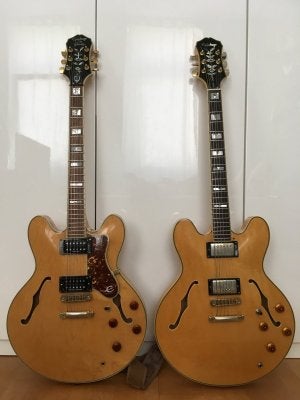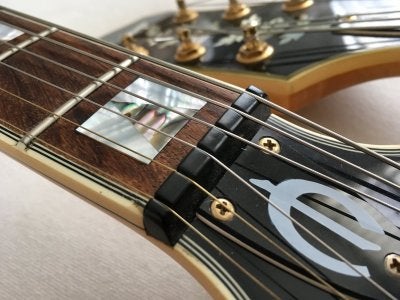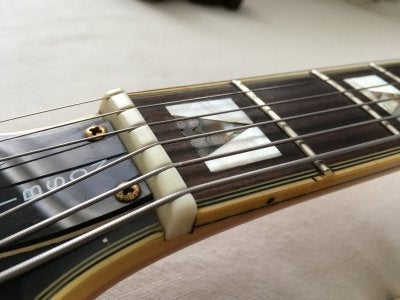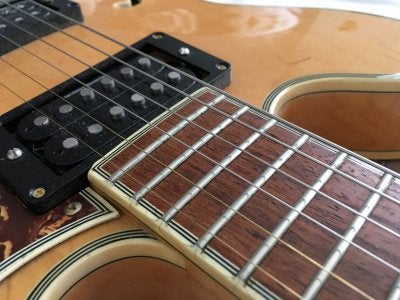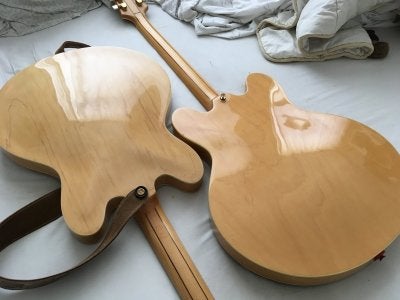deytookerjaabs
Friend of Leo's
No, it's not a 335, but it isn't so intentionally!
Let's start with a couple pics:


Firstly, the neck pocket will give us some specs. It's a real 5 piece neck, which is by no means a "cheap" thing, after all that's a main feature on the coveted and expensive Gibson L5 Archtop. As we see, it's a very clean pocket as well. The tenon goes to the rout and the spliced heel beneath extends further below just like you'd see on a vintage ES335 guitar, here's a 62' ES335 as an example:
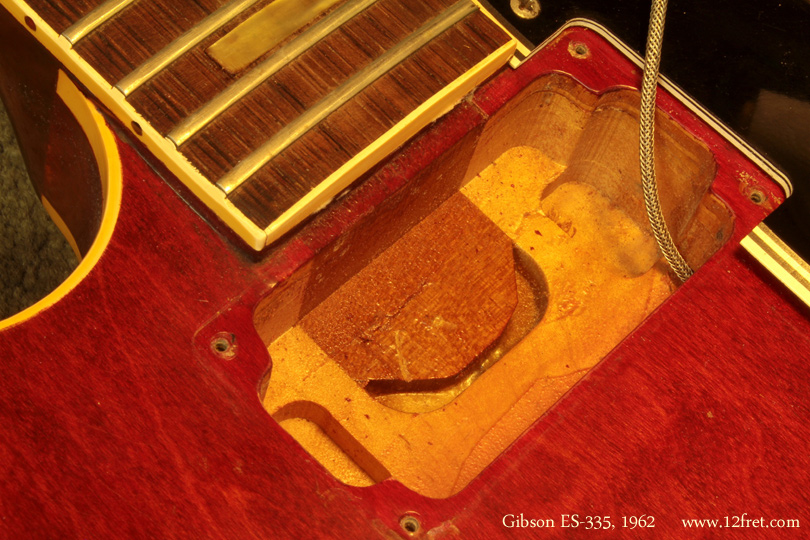
Next, take a look at the fretwork and the board itself. The board is about as dry and quality as a good piece of rosewood from any domestic supplier, no cheap faux darkened waxy thing going on here, just a quality board. The MOP and Abalone? Same deal, no plastic there, that's the real stuff to most anyone who's seen the difference in person. Add to that, old fashioned nibbing where the binding (which is also on par with domestic suppliers) is filed and seals the fret end.
The top: it's a 5 ply Maple/Birch/Maple/Birch/Maple laminate which was a feature on vintage Rivieras and Sheratons also built in the "golden era" along with the Mahogany center block. Once again, not a corner cutting feature as some like to claim.
The Hardware: It's steel, and DURABLE heavier steel at that! Now, I'm not a fan of the fat bridge but there's no pot metal happening there, the tuners are as strong as the best grovers out there too. The pots are quality mini pots and need to be mini because another addition to the Sheraton: bound F-Holes, which make fitting a standard size pot in there near impossible without filing. Add to that, the 3 way switches seem to hold up much better than those on brand new domestic guitars.
The Pickups: Okay, with all the options today I'd say "meh" only because they're definitely more on the modern end rather than hip vintage spec.
The Finish: I'd guess Polyester but might be Polyurethane. But, it's thin, or at least not pooling up at the seams or creating what looks like a glass countertop as the wood grains still shows quite well. It's also very uniform on all the early sheratons I've seen too. So you know it's applied well, given quality sanding between coats and obviously buffed beyond my standards.
Now, why 96? Well sometime around then things start being less consistent across the board. No more fret nibs plus varying wire profiles, the hardware starts to change/cheapen, the rosewood looks more like a typical low end import, the neck pocket changes and the top changes as well, here's a few pics:


How to tell if the guitar is Pre 96' MIK?
Well, two main clues, it's a guarantee if it has the "Epiphone by Gibson headstock" firstly.
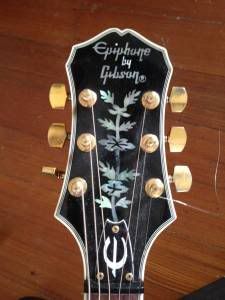
Second, often but not exclusive to Pre 96' was the regular Epiphone headstock but the truss rod cover reads "Gibson" after Gibson was taken off the headstock.

As far as I've seen, none of the earlier MIK sheratons have the "E" truss rod cover like they started to put on in the late 90's which looks like this:
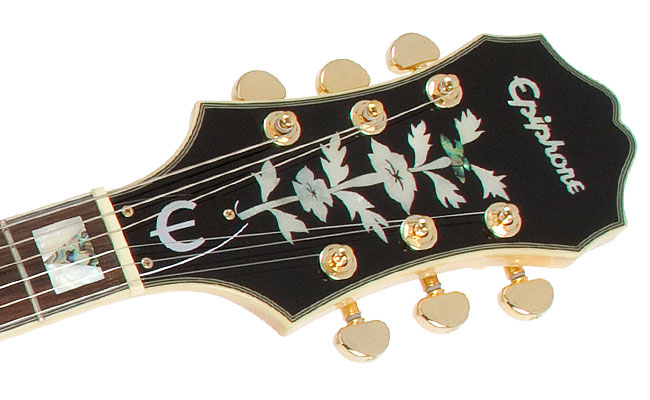
So, although I'd say it's a different guitar than a 335 the earlier MIK Sheratons are a very well made guitar, with attention to detail, and very few (arguably, if any) corners cut compared to many similar imports. Aside from not being lacquer and perhaps the pickups, there's nothing that separates the guitar from a quality domestic build, it's very "high spec" without just being fancy-looking.
Oh, and they bid for $300-$400 on ebay.
Let's start with a couple pics:


Firstly, the neck pocket will give us some specs. It's a real 5 piece neck, which is by no means a "cheap" thing, after all that's a main feature on the coveted and expensive Gibson L5 Archtop. As we see, it's a very clean pocket as well. The tenon goes to the rout and the spliced heel beneath extends further below just like you'd see on a vintage ES335 guitar, here's a 62' ES335 as an example:

Next, take a look at the fretwork and the board itself. The board is about as dry and quality as a good piece of rosewood from any domestic supplier, no cheap faux darkened waxy thing going on here, just a quality board. The MOP and Abalone? Same deal, no plastic there, that's the real stuff to most anyone who's seen the difference in person. Add to that, old fashioned nibbing where the binding (which is also on par with domestic suppliers) is filed and seals the fret end.
The top: it's a 5 ply Maple/Birch/Maple/Birch/Maple laminate which was a feature on vintage Rivieras and Sheratons also built in the "golden era" along with the Mahogany center block. Once again, not a corner cutting feature as some like to claim.
The Hardware: It's steel, and DURABLE heavier steel at that! Now, I'm not a fan of the fat bridge but there's no pot metal happening there, the tuners are as strong as the best grovers out there too. The pots are quality mini pots and need to be mini because another addition to the Sheraton: bound F-Holes, which make fitting a standard size pot in there near impossible without filing. Add to that, the 3 way switches seem to hold up much better than those on brand new domestic guitars.
The Pickups: Okay, with all the options today I'd say "meh" only because they're definitely more on the modern end rather than hip vintage spec.
The Finish: I'd guess Polyester but might be Polyurethane. But, it's thin, or at least not pooling up at the seams or creating what looks like a glass countertop as the wood grains still shows quite well. It's also very uniform on all the early sheratons I've seen too. So you know it's applied well, given quality sanding between coats and obviously buffed beyond my standards.
Now, why 96? Well sometime around then things start being less consistent across the board. No more fret nibs plus varying wire profiles, the hardware starts to change/cheapen, the rosewood looks more like a typical low end import, the neck pocket changes and the top changes as well, here's a few pics:


How to tell if the guitar is Pre 96' MIK?
Well, two main clues, it's a guarantee if it has the "Epiphone by Gibson headstock" firstly.

Second, often but not exclusive to Pre 96' was the regular Epiphone headstock but the truss rod cover reads "Gibson" after Gibson was taken off the headstock.

As far as I've seen, none of the earlier MIK sheratons have the "E" truss rod cover like they started to put on in the late 90's which looks like this:

So, although I'd say it's a different guitar than a 335 the earlier MIK Sheratons are a very well made guitar, with attention to detail, and very few (arguably, if any) corners cut compared to many similar imports. Aside from not being lacquer and perhaps the pickups, there's nothing that separates the guitar from a quality domestic build, it's very "high spec" without just being fancy-looking.
Oh, and they bid for $300-$400 on ebay.




